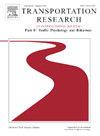危险情况下的驾驶行为:风险情景与维度情绪之间的相互作用
IF 3.5
2区 工程技术
Q1 PSYCHOLOGY, APPLIED
Transportation Research Part F-Traffic Psychology and Behaviour
Pub Date : 2024-10-11
DOI:10.1016/j.trf.2024.10.004
引用次数: 0
摘要
随着道路交通系统中人-车-环境各要素之间矛盾的加剧,由此引发的交通安全问题也日益严峻。情绪作为影响安全驾驶的关键心理因素,直接影响驾驶者对周围信息的感知和判断。同时,驾驶过程中的潜在风险也会影响驾驶者的决策和驾驶行为。本研究在维度情绪定义的基础上,分析了不同的情绪价值、唤醒程度和风险水平情景对驾驶者避免碰撞行为的影响。共有 21 名年龄在 18 至 50 岁之间、驾龄在 1 至 10 年之间的驾驶员参加了模拟驾驶实验。本研究采用决策树(DT)算法来定义不同驾驶行为的发生与影响因素之间的定量关系。它预测了两种紧急情况下的车辆避让行为,以确定是否能避免碰撞。结果表明,当情绪和风险水平信息相结合时,该模型的预测准确率有所提高,达到 88.89 %。这比仅使用情绪信息的模型提高了 5.56%,比仅使用风险水平信息的模型提高了 2.53%。与主观情绪因素对驾驶行为的影响相比,风险情景对驾驶行为的影响呈现出更加稳定的趋势。在情绪和风险因素的交互作用下,基于决策树(DT)算法的驾驶行为预测模型的准确性和泛化能力得到了极大的提高。该研究为解决驾驶员情绪导致的不良驾驶行为以及分析避免碰撞过程的影响因素提供了理论依据。本文章由计算机程序翻译,如有差异,请以英文原文为准。
Driving behavior in Hazardous situations: The interplay between risk scenarios and dimensional emotions
As the contradictions among the human-vehicle-environment elements in road traffic systems intensify, the resulting traffic safety issues are becoming increasingly severe. Emotions, as critical psychological factors influencing safe driving, directly impact drivers’ perceptions and judgments of surrounding information. Simultaneously, potential risks during the driving process can affect drivers’ decisions and driving behavior. On the basis of the definition of dimensional emotions, this study analyzes the impact of different valence, arousal, and risk level scenarios on drivers’ collision avoidance behavior. A total of 21 drivers aged 18 to 50 years, with driving experience ranging from 1 to 10 years, participated in a simulated driving experiment. This study employs the decision tree (DT) algorithm to define the quantitative relationship between the occurrence of different driving behaviors and their influencing factors. It predicts vehicle avoidance behavior in two emergency conditions to determine whether collision avoidance can be achieved. The results indicate that the model’s prediction accuracy improves when emotion and risk level information are combined, reaching 88.89 %. This is a 5.56 % improvement over the model using only emotion information and a 2.53 % improvement over the model using only risk level information. Compared with the impact of subjective emotional factors on driving behavior, risk scenarios exhibit a more stable trend in influencing driving behavior. Under the interaction of emotions and risk factors, the accuracy and generalization ability of the driving behavior prediction model based on the Decision Tree (DT) algorithm have been greatly improved. This research provides a theoretical basis for addressing adverse driving behavior caused by driver emotions and analyzing the factors influencing collision avoidance processes.
求助全文
通过发布文献求助,成功后即可免费获取论文全文。
去求助
来源期刊
CiteScore
7.60
自引率
14.60%
发文量
239
审稿时长
71 days
期刊介绍:
Transportation Research Part F: Traffic Psychology and Behaviour focuses on the behavioural and psychological aspects of traffic and transport. The aim of the journal is to enhance theory development, improve the quality of empirical studies and to stimulate the application of research findings in practice. TRF provides a focus and a means of communication for the considerable amount of research activities that are now being carried out in this field. The journal provides a forum for transportation researchers, psychologists, ergonomists, engineers and policy-makers with an interest in traffic and transport psychology.

 求助内容:
求助内容: 应助结果提醒方式:
应助结果提醒方式:


